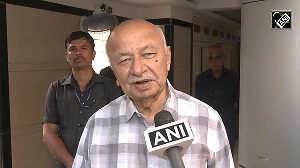 The stronger-than-expected recovery in remittances -- payments that are key to supporting the economies of many poor countries -- was driven by growth in Europe, Russia, and the United States.
The stronger-than-expected recovery in remittances -- payments that are key to supporting the economies of many poor countries -- was driven by growth in Europe, Russia, and the United States.
India has retained its position as the top remittances receiving country with its diaspora sending about USD 69 billion back home in 2017, the World Bank said today.
Remittances to India picked up sharply by 9.9 per cent to USD 69 billion in 2017, reversing the previous year’s dip, but were still short of USD 70.4 billion received in 2014.
Payments from immigrants back to their home countries rebounded to reach a new record in 2017 but the costs of transferring funds also increased, the World Bank said in a report.
The stronger-than-expected recovery in remittances -- payments that are key to supporting the economies of many poor countries -- was driven by growth in Europe, Russia, and the United States, it said.
The rebound in remittances, when valued in US dollars, was helped by higher oil prices and a strengthening of the euro and ruble.
World Bank said remittance inflows improved in all regions and the top remittance recipients were India with USD 69 billion, followed by China (USD 64 billion), the Philippines (USD 33 billion), Mexico (USD 31 billion), Nigeria (USD 22 billion), and Egypt (USD 20 billion).
India had in 2015 received remittance of USD 68.91 billion, which fell to USD 62.74 billion in the following year and has now risen to USD 68.96 billion in 2017.
The Bank estimated that officially recorded remittances to low- and middle-income countries reached USD 466 billion in 2017, an increase of 8.5 per cent over USD 429 billion in 2016. Global remittances, which include flows to high-income countries, grew 7 per cent to USD 613 billion in 2017, from USD 573 billion in 2016.
"Remittances are expected to continue to increase in 2018, by 4.1 per cent to reach USD 485 billion. Global remittances are expected to grow 4.6 per cent to USD 642 billion in 2018," it said.
The global average cost of sending USD 200 was 7.1 per cent in the first quarter of 2018, more than twice as high as the Sustainable Development Goal target of 3 per cent. Sub-Saharan Africa remains the most expensive place to send money to, where the average cost is 9.4 per cent.
Major barriers to reducing remittance costs are de-risking by banks and exclusive partnerships between national post office systems and money transfer operators. These factors constrain the introduction of more efficient technologies -- such as internet and smartphone apps and the use of crypto currency and blockchain -- in remittance services, the World Bank said.
"While remittances are growing, countries, institutions, and development agencies must continue to chip away at high costs of remitting so that families receive more of the money," said Dilip Ratha, lead author of the report.
The World Bank asked countries to take steps to simplify the process to reduce the costs, including "introducing more efficient technology."
By region, Europe and Central Asia saw the biggest growth last year, jumping 21 per cent, while Sub-Saharan Africa rose 11 per cent.
East Asia and the Pacific saw the biggest inflows of USD 130 billion, as South Asia received USD 117 billion, followed by Latin America with USD 80 billion.


.jpg)









 © 2025
© 2025